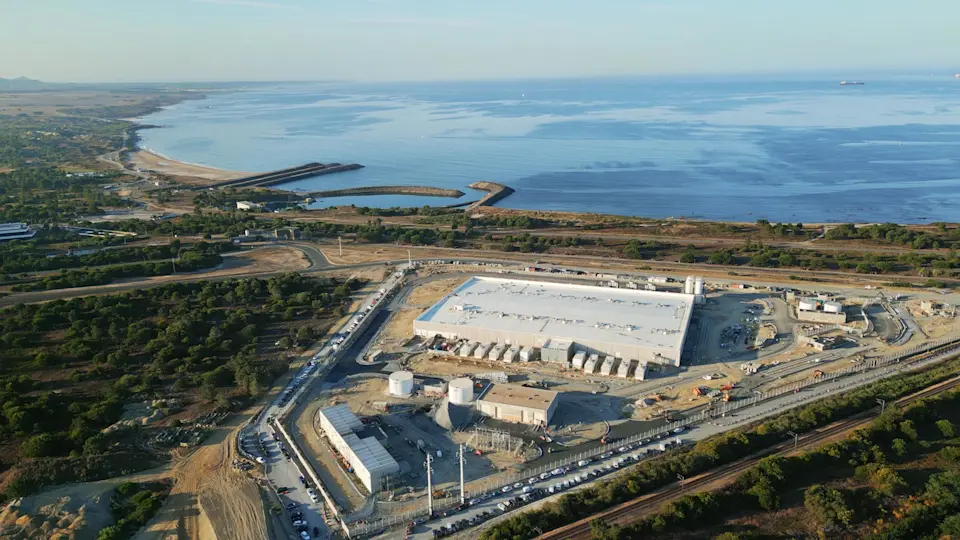
Sines Data Center Campus. Credit: Start Campus
Portugal is making global headlines again, this time for its innovative use of seawater in one of Europe’s biggest tech infrastructure projects. The Sines Data Center, located in the coastal town of Sines, is now home to Europe’s largest data centre campus. But what sets it apart is how it is cooled, not by traditional methods, but by the Atlantic Ocean.
This massive €8.5 billion investment by Start Campus is one of Portugal’s most ambitious tech projects ever built. Located on the site of a former coal-fired power station, the new Sines Data Center Campus is a bold symbol of change. It is proof that Portugal is not only moving away from fossil fuels but also taking a leading role in the global shift toward green technology.
The campus will eventually have the capacity to handle 1.2 gigawatts of power, making it one of the most powerful data hubs in the world. But instead of relying on energy-hungry air conditioning, the system uses cold seawater to cool down thousands of servers. This method saves energy and avoids using precious freshwater, a growing concern in many parts of the world.
Seawater cooling is one of the many sustainable technologies used in the project. The campus is also powered by 100 per cent renewable energy, mostly from solar and wind sources. This combination of clean power and natural cooling means the facility can offer high-performance data services with a much smaller carbon footprint.
The project is already having a significant impact on the local economy. It is expected to create up to 1,200 direct jobs and over 8,000 indirect ones by 2028. Many of these roles will be in engineering, construction, logistics, and data management, greatly boosting the region’s workforce.
But the benefits go beyond jobs. The presence of a major data centre is helping to attract more digital businesses to the area. Sines is becoming a new digital gateway for Europe, especially for companies that want to move data between Europe, Africa, and the Americas. Subsea cables that carry nearly all of the world’s internet traffic are connected directly to the Sines site, making it an ideal location for global tech firms.
Portugal’s position on the Atlantic coast makes it perfect for this infrastructure. Sines is already one of the most important ports in Europe and is ranked 14th on the continent. It offers easy access to shipping routes and has enough space and power capacity to support large-scale digital growth.
The national government and regional authorities are also investing heavily in infrastructure to support the data campus. This includes expanding the road between Sines and Beja, improving rail connections, and modernising local utilities.
The Sines Data Center Campus is privately funded, with support from international investors who believe in Portugal’s role in the future of green tech. It also shows confidence in the country’s stability, infrastructure, and commitment to renewable energy goals.
By reusing the land of a former coal plant, the project shows how Portugal is turning its industrial past into a cleaner and smarter future. It is a practical example of the country’s climate and digital goals working together.
In recent years, Portugal has taken several steps to position itself as a leader in the energy transition. The country is moving fast from solar farms in the Alentejo to offshore wind in Viana do Castelo to replace fossil fuels with clean alternatives. The Sines project adds digital power to that green portfolio.
What makes the seawater cooling system so interesting is its simplicity. Pipes bring in cold seawater from the Atlantic to cool the servers. Once the water has done its job, it is returned to the sea without harming the environment. It is a closed-loop system that uses no chemicals and requires no considerable energy input to run.
This cooling is much more efficient than traditional systems that rely on fans, compressors, and large amounts of electricity. It is also more sustainable than freshwater-based cooling, which is still used in many older data centres.
The need for more data centres will rise as the digital world grows. These centres use a lot of energy and produce heat, so finding innovative ways to manage cooling is key to reducing their environmental impact.
With its ocean-based cooling and full use of renewable energy, the project puts Portugal at the heart of the green tech movement. And for a country known for its sun, sea, and sustainability, that feels like the perfect fit.



![Sunday is the last day to take advantage of the Chase refinance mortgage rate sale [Expired]](https://thenewsblend.com/wp-content/uploads/2025/12/eed000a0-caf6-11f0-baaf-499d9d48b516-768x512.jpg)


